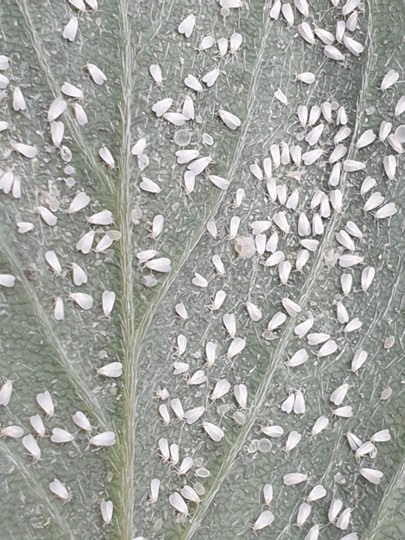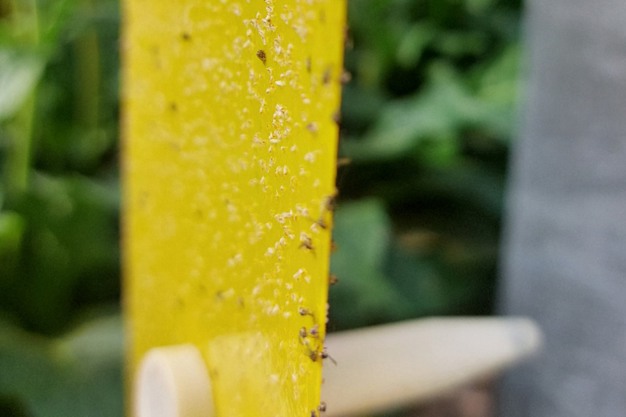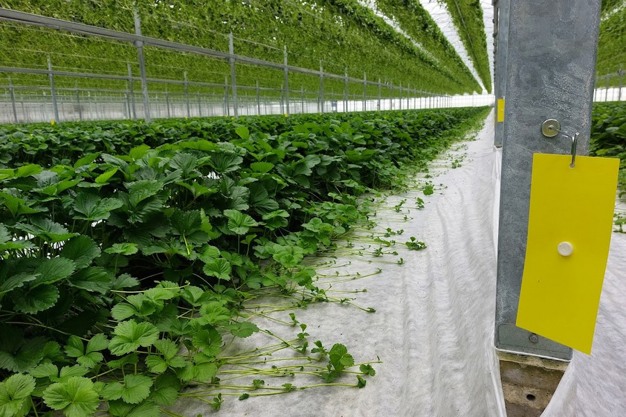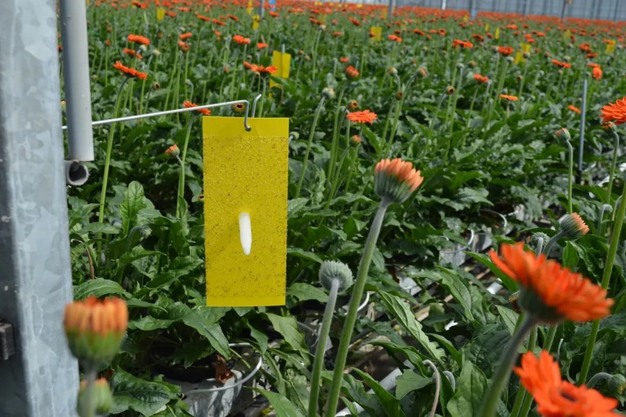In the battle against the greenhouse whitefly (Trialeurodes vaporariorum), HortiPro introduces the pheromone Pherodes as an innovative solution for the signalling and monitoring of this persistent pest. The whitefly, which has been an established pest in Dutch greenhouses since the 19th century, has a wide range of host plants including tomatoes, peppers, eggplants, gerberas, various potted plants, etc.
Adult whiteflies lay their eggs on young leaves, while the larvae, find themselves on the underside of the leaves. They cause damage by extracting nutrients and secreting honeydew, which leads to the growth of sooty mould and limited plant photosynthesis.
 Lifecycle of the greenhouse whitefly
Lifecycle of the greenhouse whitefly
The greenhouse whitefly has a development cycle of six stages, with the adult fly distinguished by its larger, white appearance and characteristic, partially overlapping, roof-shaped wings. Eggs start white and turn to purple, while the larvae and pupae are flat discs and beige ovals. The reproduction rate and the development time from egg to adulthood depend on both temperature and host plant; on tomato plants, this ranges from 21 days at 25°C to 51 days at 15°C.
Curbing the population development of the greenhouse whitefly
Given the significant damage caused by the greenhouse whiteflies, HortiPro has developed a specific pheromone to attract both male and female whiteflies to yellow sticky traps. These are equipped with a central hole of 14mm for the pheromone dispenser. The dosage of the dispensers varies per application: 20 dispensers per hectare for signalling, 50 for regular monitoring, and more than 100 dispensers per hectare for intensive monitoring.

The placement of the pheromone has been carefully considered. For example, in tomato cultivation, sticky traps are attached to roller traps and in ornamental cultivation, HortiPro advises magnetic hooks on greenhouse pole constructions. For potted plants, the sticky trap can be attached to a bamboo stick to place it among the crops.

It is recommended to monitor 20 sticky traps per hectare weekly to assess the population development and the effect of natural enemies, selective green, or chemical control. Consultant Eric Kerklaan advises: "Rotate these counting plates weekly to avoid too much counting work during the weekly scouting round. The other plates can be changed once every 4 weeks."

PheroDes at EveryD Flowers in De Lier, summer 2023
Combating whitefly larvae and adults
With PheroDes, growers gain an additional option in the fight against greenhouse whitefly. "The pheromone provides valuable insights into effective strategies for the control of greenhouse whitefly."
Also in HortiPro's portfolio is Naturalis-L. "It is an effective selective green agent on the various larval stages and adults of the greenhouse whitefly. Naturalis-L is a liquid bio-insecticide based on the active ingredient Beauveria bassiana, strain ATCC 74040. "Naturalis-L is very mild for beneficial insects and is free from MRL. In combination with the natural spreader/sticker HelioTerpen® Film the effectiveness of Naturalis-L is further enhanced."
If growers have questions or need clarification on the application strategy of this pheromone, the HortiPro team advises growers to contact their crop protection advisor. "They can arrange an appointment for you with HortiPro. By forming a collaboration between customer, supplier, and producer, we can combat the greenhouse whitefly in an integrated and effective manner."
For more information:
HortiPro
[email protected]
www.hortipro.com
